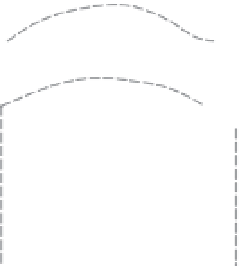Agriculture Reference
In-Depth Information
high-quality yield (Hanan, 1998). It must
not be forgotten that the economic objective
must dictate the selection of the set point
temperatures, if heating is used.
The thermal integral allows for quanti-
fication of the accumulated effects of tem-
perature on the development processes of
the plants; thus, the duration of one devel-
opment stage depends, under normal condi-
tions, on the thermal integral (see Chapter 3),
even when the day and night temperatures
are different (Slack and Hand, 1983).
In heated greenhouses, it has been rec-
ommended to adapt the night temperatures to
the solar radiation of the previous day, to limit
the heating costs without affecting growth
(Gary, 1989). So, in a low radiation day higher
night temperatures, as those required after a
high radiation day, are not required, for a
proper redistribution of the assimilates of the
previous day. In a similar way, the use of
decreasing temperatures throughout the night,
in the form of cascade (split night tempera-
ture) will save costs without negatively affect-
ing growth (Toki
et al
., 1978). Relevant energy
savings can be achieved adapting the heating
conditions to the external environment, main-
taining lower set point temperatures in the
absence of wind (Spanomitsios, 2001).
The difference between day and night
temperatures, which is known as DIF, influ-
ences different aspects of growth such as
the elongation of the internodes and stem
growth (Erwin and Heins, 1995). When DIF
is positive (
T
during day higher than
T
dur-
ing night) the internodes are longer and, on
the contrary, when DIF is negative, plants
are more compact, as internodes are shorter
(Challa
et al
., 1995). This DIF mechanism is
related to phytochrome (Moe
et al
., 1992)
and is of particular interest in ornamental
horticulture.
In daily management, the minimum
temperature thresholds during the day must
be from 6 to 11°C higher than those of the
night on sunny days; a difference that must
range from 3 to 6°C on cloudy days (ASAE,
2002). Other authors (Berninger, 1989) rec-
ommend limiting these differences in win-
ter, maintaining the day temperature from 3
to 4°C higher than the night temperature on
cloudy days and from 6 to 8°C higher on
sunny days (Fig. 7.12).
The majority of horticultural species
cultivated in greenhouses in the
Mediterranean Basin experience a great
reduction of their metabolic activity below
10-12°C (Nisen
et al
., 1988), their optimum
Ventilation
B
C
Heating
A
D
Dawn
Dusk
24
Time (h)
Fig. 7.12.
Scheme of the set point temperatures for heating and ventilation management in a climatized
greenhouse over 24 h. A, Starting point of the set point increase; B, sunrise (final point of the set point
increase); C, starting point of the set point decrease (near sunset); D, final point of the set point decrease;
dotted lines, possible high temperatures during daylight hours. The set points for heating and ventilation
are calculated with regard to sunrise and sunset, when solar radiation begins and finishes, respectively
(adapted from Bakker
et al
., 1995).


